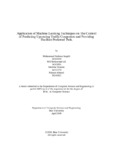| dc.contributor.advisor | Arif, Hossain | |
| dc.contributor.author | Saquib, Muhammad Sadman | |
| dc.contributor.author | Ali, Mili Mohammad | |
| dc.contributor.author | Tazmim, Marisha | |
| dc.contributor.author | Ahmad, Faiyaaz | |
| dc.date.accessioned | 2019-07-02T06:58:54Z | |
| dc.date.available | 2019-07-02T06:58:54Z | |
| dc.date.copyright | 2019 | |
| dc.date.issued | 2019-04 | |
| dc.identifier.other | ID 14101030 | |
| dc.identifier.other | ID 14101056 | |
| dc.identifier.other | ID 14101170 | |
| dc.identifier.other | ID 18241021 | |
| dc.identifier.uri | http://hdl.handle.net/10361/12295 | |
| dc.description | This thesis is submitted in partial fulfillment of the requirements for the degree of Bachelor of Science in Computer Science and Engineering, 2019. | en_US |
| dc.description | Cataloged from PDF version of thesis. | |
| dc.description | Includes bibliographical references (pages 36-37). | |
| dc.description.abstract | Bangladesh being one of the most heavily populated country in the world, the traffic condition is worsening every year due to the increase of vehicle activities through- out the entire nation. Research claims that an average person in Dhaka spends up to 7 years of his/her lifetime just sitting in traffic. Without the proper knowledge of traffic situation, it is very hard to schedule our work and execute them accordingly. So, it is necessary to present a method that can predict the upcoming traffic congestion and by using that valuable information, it will help us to execute our chores in a way that will enable us to make the best and most effective use of our times. Since the growth of Intelligent Traffic System (ITS) has been upgrading in a quite effective way, it has enabled a vast areas and methods to analyze and predict traffic density. Our research proposes a way to predict the upcoming traffic density based on using different regression analysis techniques and using these prediction results, we can provide the best suited and less time consuming possible route for the user. The traffic dataset has been collected form Uber Movements for the city of Mumbai, India. We decided to choose this particular country since India is the closest and has the most similarities to our societal environment. We have processed the data and applied multiple machine learning techniques and from them we chose the best methods with the most optimum accuracy of over 75 percent. In this study, we attempted to find some better traffic prediction results by implementing Lin- ear Regression model, Logistic Regression model. We have initiated our works in an android based application which shows us the best possible route based on the upcoming traffic congestion according to different dates and routes. Hopefully, our research will be able to contribute to finding more enhanced predictions of day to day traffic congestion and enabling our users to plan their schedule ahead of time using these predictions results. | en_US |
| dc.description.statementofresponsibility | Muhammad Sadman Saquib | |
| dc.description.statementofresponsibility | Mili Mohammad Ali | |
| dc.description.statementofresponsibility | Marisha Tazmim | |
| dc.description.statementofresponsibility | Faiyaaz Ahmed | |
| dc.format.extent | 37 pages | |
| dc.language.iso | en | en_US |
| dc.publisher | Brac University | en_US |
| dc.rights | Brac University theses are protected by copyright. They may be viewed from this source for any purpose, but reproduction or distribution in any format is prohibited without written permission. | |
| dc.subject | Traffic congestion | en_US |
| dc.subject | Congestion prediction | en_US |
| dc.subject | Machine learning | en_US |
| dc.subject | Regression analysis | en_US |
| dc.subject | Intelligent Transport System (ITS) | en_US |
| dc.subject | Correlation | en_US |
| dc.subject | Logistic regression | en_US |
| dc.subject.lcsh | Traffic engineering. | |
| dc.subject.lcsh | Traffic flow--Bangladesh--Management. | |
| dc.title | Application of machine learning techniques on the context of predicting upcoming traffic congestion and providing the best preferred path | en_US |
| dc.type | Thesis | en_US |
| dc.contributor.department | Department of Computer Science and Engineering, Brac University | |
| dc.description.degree | B. Computer Science and Engineering | |

